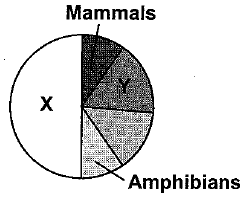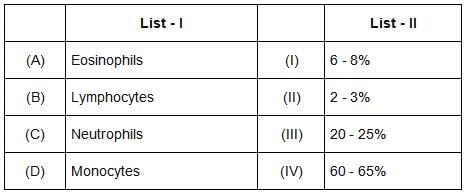SRMJEEE Biology Mock Test - 10 - JEE MCQ
30 Questions MCQ Test - SRMJEEE Biology Mock Test - 10
The given pie diagram represents the proportionate number of species of major taxa of vertebrates. Identify the group A and B.


Consider the following statements about the human circulatory system and related disorders. Identify which statements are correct:
(a) The tunica media consists of smooth muscle and elastic fibers and is thinner in veins than in arteries.
(b) The systemic circulation carries oxygenated blood from the lungs to the tissues of the body.
(c) The hepatic portal system directly transports blood from the liver to the heart.
(d) Adrenal medullary hormones decrease the cardiac output.
(e) Coronary Artery Disease is characterized by the narrowing of arterial lumen due to the buildup of fatty materials.
(a) The tunica media consists of smooth muscle and elastic fibers and is thinner in veins than in arteries.
(b) The systemic circulation carries oxygenated blood from the lungs to the tissues of the body.
(c) The hepatic portal system directly transports blood from the liver to the heart.
(d) Adrenal medullary hormones decrease the cardiac output.
(e) Coronary Artery Disease is characterized by the narrowing of arterial lumen due to the buildup of fatty materials.
In Which of the following diseases alevolar walls are damaged due to decrease in respiratory surface?
What is the primary function of chlorophyll a in photosynthesis?
Which of the following is a unit of primary productivity?
Assertion: The innermost layer of microsporangium is called tapetum.
Reason: Tapetum performs the function of protection and help in dehiscence of anther to release pollen grains.
Column I
i. Down’s syndrome
ii. Klinefelter’s syndrome
iii. Turner’s syndrome
Column II
a. Broad palm with characteristic palm crease
b. Gynaecomastia
c. Rudimentary ovaries
d. XO
e. XXY
f. Physical development is retarded.
The drug which binds to specific opioid receptors present in our central nervous system and gastrointestinal tract is:
Enzymes are mainly functional inside the living cells. Which of the following factors influence(s) enzyme activity?
What is the primary purpose of passing effluent into a settling tank after reducing BOD?
In recombinant DNA technology, what is the purpose of a bioreactor in the large-scale production of desired proteins?
Physical removal of large and small particle from the sewage through filtration and sedimentation is called?
The exchange of segments of non-sister chromatids between chromosomes of a homologous pair is termed as
G2 Phase prepares the cell to undergo division. Which of the following is the characteristic of G2 Phase?
Simple cuboidal epithelium lines all the following structures except the ___________.
What is the significance of the dikaryotic phase in the life cycle of Basidiomycetes?
Select the correctly written scientific name of Mango which was first described by Carolus Linnaeus.
In the human neural system, the coordination between different organ systems is essential for maintaining homeostasis during physical activities.
Which of the following statements best explains the roles of the central nervous system (CNS) and the peripheral nervous system (PNS) during intense physical exercise?
i. Anti-retroviral drugs can completely cure HIV/AIDS.
ii. Anti-retroviral drugs help control the replication of the virus and prolong the life of the patient.
iii. There is no vaccine available for HIV prevention, but safe sex practices can reduce transmission.
iv. HIV treatment is only effective during the early stages of infection.
Match List-I with List-II.

Choose the correct answer from the options given below :
Microsporangium is generally surrounded by _____ wall layers and the layer that performs the function of providing nutrition to pollen is ______.
Which of the following statements regarding nucleic acids is/are correct?
i. Nucleic acids are comprised of polynucleotides that contain ribose or deoxyribose sugars.
ii. The building blocks of nucleic acids are amino acids.
iii. The nitrogenous bases adenine, guanine, uracil, cytosine, and thymine are found in nucleic acids.
iv. DNA is a type of nucleic acid that contains ribose sugar.
Tertiary structure of protein is formed by __________
Read the following statements and select the correct ones.
(i) Nodal tissue is specialised cardiac musculature in human heart which has the ability to generate action potential due to an external stimuli
(ii) Position of SAN - right corner of right atrium
(iii) Position of AVN - right corner of ventricle
(iv) AV bundle continues from AVN
(v) Purkinje fibres are modified cardiac muscle fibres that originate from the atrioventricular node and spread into the two ventricles.














